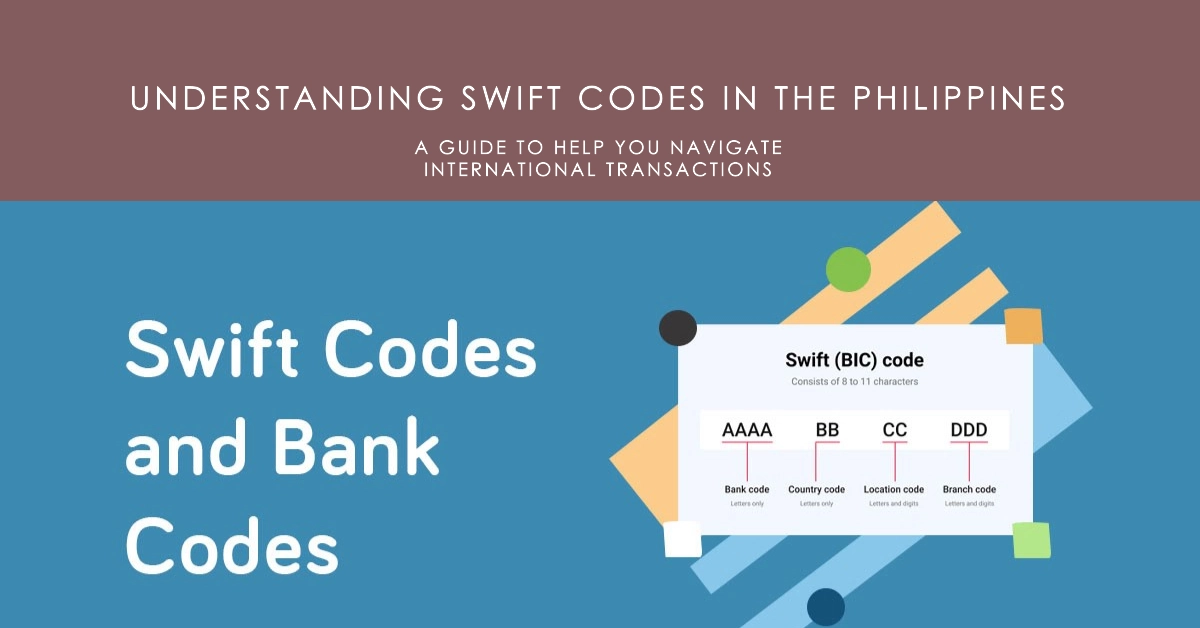If you’ve ever engaged in international money transfers to or from a Philippine bank, you probably encountered the term “SWIFT code.” These codes play a crucial role in making sure your funds arrive at their destination without a hitch.
In this guide, we’ll explain what SWIFT codes are, their structure, and how they facilitate seamless international financial transactions.
What are SWIFT Codes?
- Definition: A SWIFT code (sometimes referred to as a BIC code) is a unique identification code assigned to banks and financial institutions globally. SWIFT stands for the Society for Worldwide Interbank Financial Telecommunication, the organization that manages this standardized system.
- Purpose: SWIFT codes provide a secure and standardized way to identify banks involved in international money transfers. Think of them as an international address for your bank, ensuring your funds are routed correctly.
- Importance: When sending or receiving money internationally, having the correct SWIFT code is essential. An incorrect SWIFT code can delay your transaction or even cause it to fail altogether.
Understanding SWIFT Code Structure
A SWIFT code consists of 8-11 characters, formatted like this:
- AAAA BB CC DDD
- AAAA: The first 4 characters represent the bank code.
- BB: The next 2 characters represent the country code (PH for the Philippines).
- CC: The following 2 characters represent the location/city code.
- DDD: The last 3 characters (optional) represent the specific branch code.
Example: The SWIFT code for the main branch of the Bank of the Philippine Islands (BPI) is BOPIPHMM. Let’s break it down:
- BOPI: Represents the Bank of the Philippine Islands.
- PH: Identifies the country as the Philippines.
- MM: Represents the location as Manila.
How SWIFT Codes Work in International Transfers
Here’s how SWIFT codes help ensure international transactions go smoothly:
- Initiating a Transfer: When you want to send money to an account in the Philippines from overseas, you’ll need to provide the following information to your bank:
- Recipient’s full name
- Recipient’s bank account number
- Recipient’s bank name and branch
- Recipient’s bank’s SWIFT code
- SWIFT Network: Your bank utilizes the SWIFT network to securely transmit the transfer instructions, including the provided SWIFT code, to the recipient’s bank in the Philippines.
- Bank Identification: The SWIFT code enables the SWIFT network to correctly identify the specific bank and branch where the funds should be deposited.
- Transfer Completion: Once the recipient’s bank is identified, the funds are transferred into the designated account.
How to Find a SWIFT Code in the Philippines
Here are easy ways to find the SWIFT code you need:
- Check the Bank’s Website: Most banks in the Philippines list their SWIFT codes on their official websites, often in sections like “International Payments” or “About Us.”
- Examine Bank Statements: Your bank statements usually contain your bank’s SWIFT code.
- Contact Customer Service: Reach out to your bank’s customer service by phone, email, or visiting a branch, and they’ll gladly provide the SWIFT code.
- Online SWIFT Code Finders/Websites: These dedicated websites allow you to search for specific SWIFT codes. Here are a few reliable options:
- A popular SWIFT code finder
- wise.com (formerly TransferWise): Offers both a SWIFT code lookup tool and additional information about international transfers
Swift Codes for Major Banks in the Philippines
Below are some of the major banks in the Philippines and their SWIFT codes. Be aware that branch-specific codes might exist:
- BDO Unibank, Inc.: BNORPHMM
- Bank of the Philippine Islands (BPI): BOPIPHMM
- Metropolitan Bank & Trust Company (Metrobank): MBTCPHMM
- Philippine National Bank (PNB): PNBMPHMM
- Land Bank of the Philippines (Landbank): TLBPPHMM
- Rizal Commercial Banking Corporation (RCBC): RCBCPHMM
- Security Bank Corporation: SETCPHMM
- China Banking Corporation: CHBKPHMM
- Union Bank of the Philippines: UBPHPHMM
- Development Bank of the Philippines (DBP): DBPHPHMM
Important note: SWIFT codes can occasionally change due to bank mergers or updates. A list compiled now might have inaccuracies later.
For Smaller/Less Common Banks:
- Check Bank Statements: Your bank statements often contain the SWIFT code.
- Contact Customer Support: Banks can always provide their most up-to-date SWIFT codes.
Important Note: Always double-check the SWIFT code for your intended transaction, especially for smaller banks or specific branches. Using the resources above ensures you have the most current information.
Final Notes
SWIFT codes are integral to the efficient and secure processing of international money transfers. If you’re involved in a financial transaction beyond the Philippines, make sure you have the correct SWIFT code of the relevant bank or financial institution. Use the strategies discussed to locate any SWIFT code hassle-free.
FAQs
-
What exactly is a SWIFT code, and why do I need it?
A SWIFT code (or BIC) uniquely identifies a specific bank worldwide, ensuring international money transfers arrive at the correct destination. You’ll need it to send or receive funds from abroad.
-
Where can I find the SWIFT code of a bank in the Philippines?
There are several ways: * Look on the bank’s official website (often in the “International Payments” section). * Check your bank statements. * Contact the bank’s customer service directly. * Use online SWIFT code finder websites.
-
Can all branches of a bank have the same SWIFT code?
Usually, all branches of a bank share the same initial 8-character SWIFT code. However, individual branches sometimes have unique final 3-character extensions. If unsure, verify the SWIFT code specific to the branch where the account is held.
-
What happens if I use the wrong SWIFT code?
An incorrect SWIFT code can lead to delays in your international transfer, potential extra fees, or even the failure of the transaction. Double-check the code before initiating a transfer.
-
Do I need a SWIFT code to make domestic (within the Philippines) transfers?
No, SWIFT codes are specifically for international money transfers. Domestic bank transfers within the Philippines typically use different identification systems.
-
Is there a fee for using SWIFT codes?
While SWIFT codes themselves don’t have a fee, both the sending and receiving banks usually charge fees associated with international wire transfers.
-
Can I receive money if I only provide my bank account number?
If the money is coming from outside the Philippines, providing your account number alone isn’t enough. The sender also needs your bank’s SWIFT code, your full name, and potentially your branch information to ensure the transfer is successful.

